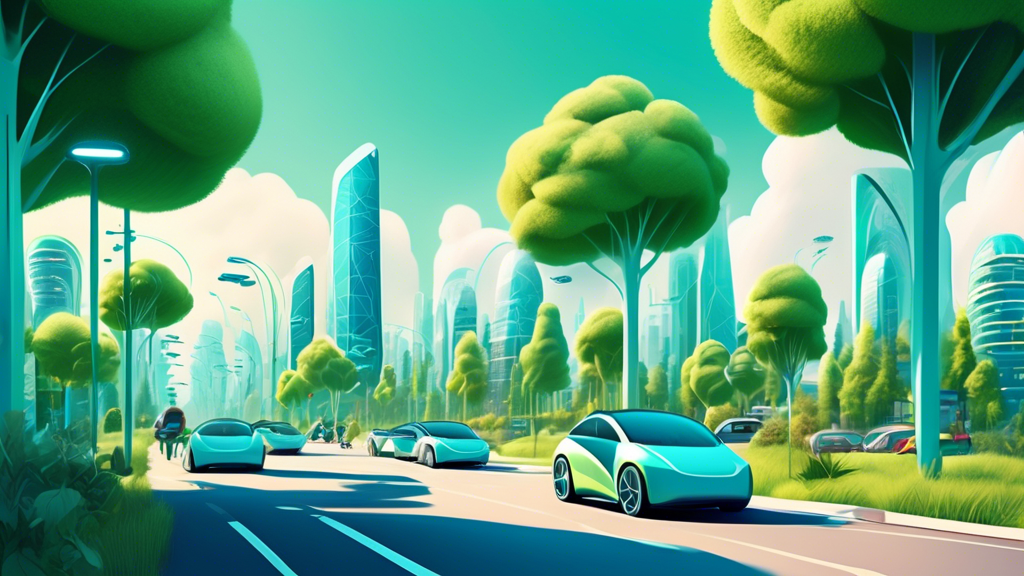Ever wondered how electric vehicles are transforming our planet? The rise of EVs is not just a fleeting trend; it’s a revolution. Electric vehicles (EVs) are powered by electricity instead of traditional fossil fuels, offering a cleaner, greener way to travel. These marvels of modern engineering have come a long way since their inception. From the humble beginnings of early battery-powered cars to today’s sleek, high-performance models, the journey of EVs is fascinating.
In today’s world, where pollution and climate change dominate headlines, the importance of electric vehicles can’t be overstated. They promise a significant shift towards a sustainable future, playing a crucial role in reducing our carbon footprint. Imagine a world where every vehicle on the road contributes to cleaner air and a healthier environment. Sounds too good to be true? Let’s delve into how EVs are making this dream a reality.
By slashing greenhouse gas emissions, electric vehicles are champions in the fight against climate change. Did you know that experts project EVs could cut millions of tons of carbon dioxide from our atmosphere? Additionally, reducing air pollution isn’t just good for the planet—it’s good for us too. Less pollution means fewer health issues and cleaner air for everyone. When stacked against traditional internal combustion engine vehicles, EVs come out ahead in efficiency and sustainability, proving they aren’t just a novelty—they’re a necessity.
Looking ahead, the future of EVs gleams with promise. Innovations in battery technology are making them more efficient and faster to charge. Governments worldwide are stepping in with policies and incentives, encouraging the adoption of these green machines. And let’s not forget the exciting developments in autonomous driving and smart grids, all poised to make EVs even more integrated with renewable energy.
Are you ready to explore the green impact of EVs? Buckle up for a journey into the world of electric vehicles and discover how they’re shaping a cleaner, brighter future for us all.
Introduction to Electric Vehicles (EVs)
Brief Overview of EVs: What They Are and How They Work
Ever wondered what sets electric vehicles (EVs) apart from their gasoline-guzzling counterparts? EVs run solely on electric power. They rely on rechargeable batteries to power an electric motor.
The basic components include a battery pack, an electric motor, and a power control unit. Plug an EV into a charging station, and you’re all set to go green. No tailpipe means zero direct emissions, making EVs a cleaner choice for your daily commute.
Historical Context: Evolution of Electric Vehicles
Electric vehicles are not just a product of modern technology. Believe it or not, EVs date back to the 19th century. The first successful electric car was created in 1890 by William Morrison, an American chemist.
Gasoline cars soon took the lead, thanks to Henry Ford’s mass production techniques. Yet, EVs made a notable comeback in the late 20th century with advancements in battery technology and rising environmental concerns. Nowadays, they’ve evolved into sophisticated machines that are here to stay.
Importance of Electric Vehicles in the Modern World
Why should you care about EVs today? The answer lies in their significant contribution to a sustainable future. Electric vehicles are key to reducing our global carbon footprint.
With governments worldwide pushing for greener alternatives, EVs play a crucial role in eco-friendly transportation. They offer a viable solution to the pressing issues of climate change and urban air pollution. Choosing an EV is not just a transportation choice; it’s a statement for a greener planet.

Environmental Benefits of EVs
Reduction in Greenhouse Gas Emissions: Statistics and Projections
Did you know that transportation is one of the largest contributors to greenhouse gas emissions? Electric Vehicles (EVs) offer a promising solution. Unlike their internal combustion engine (ICE) counterparts, EVs produce zero tailpipe emissions. According to the International Energy Agency, a mass shift to EVs could reduce global CO2 emissions by up to 1.5 gigatons by 2030. Imagine the impact on our planet!
Decrease in Air Pollution and Its Health Benefits
Can you picture a world with cleaner air? EVs don’t just lower greenhouse gases; they also decrease air pollutants like nitrogen oxides and particulate matter. A study by the American Lung Association found that widespread EV adoption could prevent 6,300 premature deaths by 2050. Cleaner air means healthier communities, fewer respiratory diseases, and a better quality of life.
Comparison with Traditional Internal Combustion Engine Vehicles: Efficiency and Sustainability
How do EVs stack up against traditional cars? For starters, electric motors are far more efficient than ICEs. While ICE vehicles convert only 20-30% of the energy from fuel into motion, EVs achieve efficiencies of 85-90%. More efficiency means less energy wasted. Additionally, the sustainability of EVs extends to their potential for using renewable energy sources. Charging an EV using solar or wind power amplifies its positive impact on the environment.

The Future of EVs: Trends and Innovations
Advances in Battery Technology: Longevity, Charging Speed, and Energy Density
Can you imagine an electric vehicle (EV) that charges in minutes, travels for days, and offers unparalleled efficiency? Advances in battery technology are rapidly turning this vision into reality.
Researchers are making impressive strides in enhancing the longevity of EV batteries, ensuring they last longer than ever before. Lifespan improvements mean lower replacement costs and less environmental waste.
Charging speed is another game-changer. What used to take hours can soon be done in mere minutes. This is possible thanks to innovations like solid-state batteries, which promise faster charging times and increased safety.
Energy density has also seen significant improvements, allowing EVs to travel further on a single charge. Higher energy density batteries mean more mileage without increasing the size or weight of the battery pack. In essence, you get more bang for your buck and a greener planet in return.
Government Policies and Incentives: Global and Regional Perspectives
Are government policies the secret sauce propelling the EV revolution? The answer is a resounding yes.
Globally, countries are rolling out generous incentives to promote EV adoption. These include tax rebates, subsidies, and grants that make EVs more affordable for the average consumer.
Regions like Europe and China are leading the charge by implementing stringent regulations aimed at reducing emissions. Europe has established ambitious goals to phase out internal combustion engine vehicles by 2035, while China’s EV market continues to thrive under supportive government policies.
In the United States, federal and state-level incentives play a crucial role. States like California offer additional rebates and incentives, fostering a more welcoming environment for EV adoption. These measures don’t just benefit consumers but also galvanize manufacturers to invest in research and development, increasing competition and driving innovation.
Emerging Trends: Autonomous Driving, Smart Grids, and Renewable Energy Integration
What’s next on the horizon for EVs? Autonomous driving, smart grids, and renewable energy integration represent a trifecta of transformative trends.
Autonomous driving technology is set to revolutionize how we view transportation. Imagine a world where your car drops you off at work, parks itself, and picks you up when needed. Leading tech companies and automakers are vigorously testing self-driving EVs, with some already on the roads in pilot programs.
Smart grids are another incredible innovation. These systems intelligently manage electricity consumption and production, optimizing EV charging based on grid demand and availability. The result? Reduced electricity costs and a more resilient energy infrastructure.
Lastly, the integration of renewable energy sources with EVs presents an exciting opportunity for a cleaner future. Solar panels on rooftops that charge your car, wind turbines generating electricity for public charging stations — the possibilities are endless. This synergy helps reduce dependency on fossil fuels, making EVs truly green machines.
In sum, these emerging trends and innovations position EVs not just as a sustainable alternative but as a pivotal element in our future transportation landscape. As technology continues to evolve, so too will the impact of electric vehicles, propelling us towards a more sustainable, efficient, and exciting future.
Have you ever wondered how a vehicle could transform our world for the better? Electric Vehicles (EVs) have answered that question with a resounding and electrifying impact. As we’ve seen, EVs are no longer a futuristic concept; they are an ever-present part of our lives, delivering unparalleled benefits and forging a path to a cleaner, healthier environment.
From the early days of clunky prototypes to today’s sleek, high-performing models, the journey of EVs showcases remarkable evolution. Their importance in curbing global warming cannot be overstated. With EVs producing little to no greenhouse gas emissions, their widespread adoption could significantly slow down the adverse effects of climate change. Isn’t it refreshing to think that your daily commute could actually contribute to a healthier planet?
In addition to their environmental benefits, EVs also promote better public health by reducing air pollution. Cleaner air means fewer respiratory illnesses, giving entire communities a breath of fresh air—both literally and metaphorically. Comparing EVs to traditional internal combustion engine vehicles reveals a stark contrast in efficiency and sustainability. EVs achieve higher energy efficiency and rely on increasingly greener energy sources, offering a sustainable transportation solution.
Looking ahead, the future of EVs appears even brighter. Advances in battery technology promise longer driving ranges, faster charging times, and greater energy density. Moreover, supportive government policies and incentives are accelerating the shift towards electric mobility, making EVs more accessible to everyone. Emerging trends like autonomous driving and the integration of renewable energy into smart grids are set to revolutionize the landscape further, driving us towards a world that prioritizes sustainability.
In the race to combat climate change and promote public health, EVs are leading the charge—pun intended. They represent more than just a new way to travel; they signify a global movement towards cleaner, more efficient, and sustainable living. So, as we drive into the future, let’s embrace EVs for their potential to make a tangible, positive impact on our planet.
